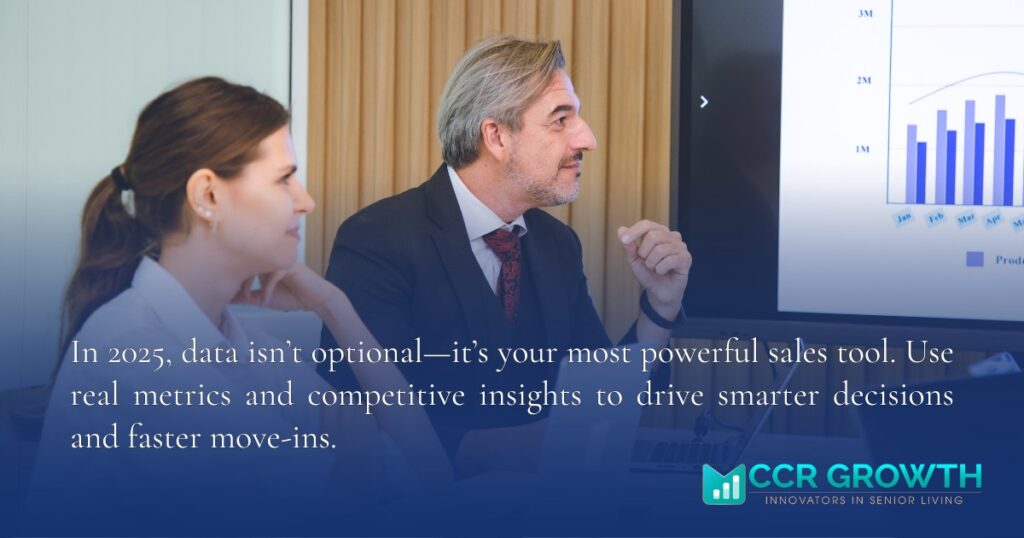
CCR Growth
Senior Living Sales and Marketing Dos and Don’ts in 2025
As the senior living industry rapidly evolves in 2025, so too must the sales and marketing strategies that power sustainable occupancy growth. The communities that thrive in this shifting environment are not those simply following traditional playbooks—they’re the ones reengineering their approach around data, emotional intelligence, and strategic integration across departments.
At CCR Growth, we’ve spent many years partnering with senior living communities to deliver performance-driven sales and marketing solutions rooted in operational discipline and technical excellence. With competition increasing and the needs of prospective residents growing more nuanced, it’s never been more critical to align every component of your sales team, marketing efforts, and resident experience strategy to exceed expectations.
This guide offers an in-depth breakdown of what to do—and what to avoid—as you lead your organization’s senior living sales and marketing strategy through the remainder of 2025 and beyond.

Outline
Published on
4/23/2025
Understanding the 2025 Senior Living Communities Environment
In 2025, senior living communities face an environment shaped by demographic shifts, increased scrutiny on cost transparency, and the expectation of digital sophistication. Prospective residents and their families are no longer just evaluating amenities—they’re analyzing websites, reviewing online testimonials, comparing pricing models, and initiating the decision making process far earlier in the funnel.
Sales goals can no longer be achieved by charisma or outdated collateral. The current environment demands tightly integrated sales and marketing strategies built around behavioral analytics, CRM intelligence, and customized journey mapping. Every touchpoint—from the first digital ad impression to the moment of move-in—must serve a measurable purpose, driving conversions through personalized, emotionally intelligent interactions.
Best Practices That Drive Results in Senior Living Sales and Marketing
To stay competitive in 2025, senior living sales professionals must approach every interaction with intention, strategy, and empathy. The following best practices reflect what works right now in high-performing communities—practical, actionable guidance designed to improve lead quality, accelerate resident moves, and strengthen relationships with prospective residents and their families.
DO: Build Strategic Personal Connections
In senior living sales, genuine relationships are the foundation of sustainable success. This is not just a transactional process—it’s an emotional one. Families are navigating fear, uncertainty, and urgency, especially in need-based situations. Your ability to build personal connection—by listening, learning, and empathizing—is more important than any brochure or virtual tour.
Sales teams must be trained to ask pointed questions and read between the lines. Identifying pain points early and addressing them with both compassion and specificity allows prospective residents to feel seen and supported. Ultimately, the value you communicate is not just in services offered, but in how those services solve deeply personal challenges.
DO: Align Sales and Marketing as a Single Engine
A common pitfall in senior living sales and marketing operations is treating the two as separate silos. In 2025, that’s no longer sustainable. High-performing communities create full alignment between lead generation, nurturing, and conversion.
Marketing teams must develop campaigns rooted in real sales feedback—messaging should reflect the objections, desires, and trends heard on the front lines. In parallel, the sales team should be fully briefed on campaign goals and content, so they can seamlessly continue the conversation with informed confidence.
Every landing page, call script, and event should be a node in a cohesive system—one that reflects shared sales goals, brand values, and the distinct value proposition of your community.
DO: Lead With Education and Transparency
Today’s prospective residents and their families demand clarity. The communities winning in 2025 are not selling hard—they’re educating well. That means your marketing strategies must be focused on delivering genuine value before asking for a commitment.
Make detailed financial planning resources, services guides, and community comparisons easily available on your website and in every stage of outreach. Transparency in cost, amenities, and limitations doesn’t weaken your pitch—it strengthens credibility.
Educated prospects are more confident and convert faster. Prioritize proactive knowledge-sharing in your sales process to empower smarter decision-making and build long-term trust.
DO: Prioritize Follow-Up That Adds Value
Follow-up is no longer a checkbox; it’s a strategy. In the current market, failing to follow up in a timely, meaningful way results in lost opportunities. But volume alone isn’t enough. Every phone call, email, and outreach should be tied to a specific insight or next step based on the prospect’s behavior and stage in the journey.
Use your CRM to personalize every message. Reference past conversations. Offer new content, answer previous questions, and invite deeper engagement. For anonymous or cold leads, creative lead generation touchpoints like community events or testimonials can re-engage interest and push them toward scheduling tours. Consistently using your CRM to track progress and manage leads also ensures that your sales team doesn’t feel overwhelmed or forced to “start over” at the beginning of each month. Instead, it empowers them to build momentum, strengthen relationships, and lead the way toward more consistent move-ins.
Follow-up done right is not pestering; it’s guiding. And in senior living sales, guidance is everything—especially when it helps maintain meaningful engagement throughout a longer decision cycle.
DO: Use Data to Drive the Sales Process
Gut instincts have their place, but in 2025, data should be leading the way. Every decision—from staffing to campaign investment—should be based on performance metrics and predictive analytics.
Track every stage of the funnel: digital ad impressions, click-through rates, form conversions, scheduled tours, tour-to-move-in ratios, and post-move-in satisfaction. This allows you to identify where your marketing efforts are succeeding, where prospects drop off, and how to course-correct with precision.
Implement regular competitive analysis to evaluate how your offerings compare within your local market. Understanding where you stand on cost, amenities, and services equips your sales team with the insights necessary to differentiate effectively.

Common Pitfalls That Undermine Sales Performance
Even the most well-meaning teams can fall into habits that hinder success. In today’s competitive senior living industry, avoiding these missteps is just as critical as adopting the right strategies. The following don’ts are based on real-world challenges we’ve seen across communities—mistakes that damage trust, slow down move-ins, and erode long-term value. Recognizing and eliminating these patterns is key to building a sales engine that’s both ethical and effective.
DON’T: Use High-Pressure Sales Tactics
Urgency without empathy leads to distrust. The senior housing decision is often emotionally fraught, and high-pressure tactics can push prospective residents and families away rather than encourage commitment.
Instead of forcing timelines or leveraging fear, focus on building momentum through clear next steps. Help them visualize life in your community, highlight the unique value you offer, and reinforce your role as a supportive guide. A rushed decision rarely results in long-term satisfaction or referrals.
DON’T: Ignore the Family Decision-Makers
While the prospective resident is central, their family often drives the final decision. Especially in assisted living and memory care, adult children are heavily involved in evaluating services, researching costs, and coordinating care.
Failing to include families in your process can stall progress or lead to disqualified leads. Equip your sales team with messaging that speaks to family concerns—safety, lifestyle, continuity of care—and ensure every piece of collateral speaks to both resident and caregiver priorities.
Family members are not just gatekeepers; they’re long-term advocates, referral sources, and community ambassadors when treated with respect.
DON’T: Assume One Message Works for All Prospects
A universal pitch will not land in 2025. Whether your target is a fiercely independent 74-year-old or an overwhelmed adult daughter looking for memory care options, the language, focus, and marketing strategies must reflect those specific pain points.
Segment your leads and develop custom pathways for each profile. For independent living, sell the lifestyle. For assisted living, focus on reassurance and support. For memory care, lead with continuity and dignity.
When messaging misses the mark, it not only weakens conversion rates but also makes families question whether your community truly understands their needs.
DON’T: Rely on Outdated Tactics
Many communities are still relying on the same sales tips and scripts they’ve used for the last decade. But 2025 demands new tactics—driven by digital engagement, behavior tracking, and content-driven conversations.
Your sales materials must reflect how today’s seniors consume information. Videos, interactive virtual tours, and real-time availability tools are expected—not exceptional. Your team must be equipped not only with product knowledge but also the tools and training to communicate in modern, compelling ways.
If your process hasn’t evolved, your success will plateau.
DON’T: Underestimate the Power of Community Experience
Once a prospect has entered your community for a tour or event, the real sales moment begins. The experience they have—conversations with other residents, interactions with staff, the atmosphere of the space—will shape their decision far more than a follow-up brochure.
Avoid over-engineering the sales pitch and under-preparing the resident experience. Train every staff member on their role in the sales and marketing ecosystem. Encourage current residents to share their stories. Make each tour a reflection of everyday life, not a performance.
Remember: Your community is your strongest closer.
Leadership Matters: Empower the Right Roles for Sales and Marketing Success
In high-performing senior living communities, leadership alignment is not just a behind-the-scenes factor—it directly impacts lead conversion, resident moves, and long-term retention. Too often, the roles of vice president, regional director, and director of sales are defined in silos, leading to inconsistent messaging, poor data flow, and diluted accountability.
In 2025, the communities seeing the most sustainable occupancy growth are those that cultivate shared responsibility across leadership. The regional director should not only oversee compliance or operations—they must be closely involved in setting strategic sales goals, evaluating marketing performance, and empowering on-site sales leaders. Meanwhile, the vice president of sales or marketing must act as a cross-functional architect—ensuring that enterprise-level goals trickle down into community-level execution without losing nuance.
At the community level, your director of sales becomes the lynchpin. This person must be given both authority and support to implement strategy, monitor KPIs, and serve as the voice of both the customer and the brand. Leadership should meet regularly to review pipeline velocity, resident move-in timelines, sales enablement gaps, training needs, and professional development goals for the sales team. A disconnected company culture results in slow decisions and missed opportunities—whereas aligned leadership enables precision, speed, and consistency across every market.
To succeed in 2025, ensure that your leadership structure is not just well-staffed, but well-connected—unified by shared metrics, joint planning, and a clearly communicated vision for occupancy growth.
From Services to Solutions: Rethink How You Sell Senior Living
One of the most urgent shifts in senior living sales today is moving from a feature-based pitch to a value-based consultation. That means reframing senior services not just as amenities, but as meaningful solutions to real problems.
For many prospective residents, the decision to move into a community is a response to a complex mix of personal, emotional, and logistical needs that evolve with age and circumstance. Safety, socialization, wellness, transportation, diet, and routine all come into play. Yet, too many sales teams still focus their pitches on floor plans and meal options. While those matter, they’re not what truly motivates a move.
In 2025, top-performing communities are coaching every person on the sales team to dig deeper. What is this family struggling with today? What service gaps are they experiencing? What emotional resistance might be preventing them from making a move—even when they know it’s the right choice?
To answer those questions, you must treat each conversation not as a presentation, but as a discovery. Translate every community offering into outcomes. Don’t just describe your wellness programming—illustrate how it restores independence and confidence. Don’t just mention transportation—frame it as a way to reduce caregiver burnout and increase resident autonomy.
Aligning senior services with prospect pain points positions your company as a true partner—not just to prospects, but to long-term clients and families who rely on your solutions. That shift transforms how families perceive value—and significantly shortens the timeline from inquiry to resident move.
Setting the Standard for Sales Success in Senior Living
The future of senior living sales and marketing isn’t built on volume or automation—it’s built on relevance, empathy, and operational excellence. Communities that develop integrated, data-driven, and emotionally intelligent systems will stay ahead of the curve. Those that don’t will struggle with stagnation and churn.
At CCR Growth, we help you replace guesswork with expertise. Our comprehensive approach to optimizing your sales, marketing, and business systems ensures every touchpoint adds value—and every strategy delivers results. From strategic planning and performance analysis to competitive analysis and conversion tracking, we partner with you to scale what works and eliminate what doesn’t.
You don’t need more tactics. You need a framework for sustainable growth. Let’s build it together.
Ready to attract qualified leads, improve conversion performance, and accelerate occupancy for your senior living community? Get in touch with CCR Growth to discover how our proven strategies, hands-on expertise, and a tailored approach to senior living sales and marketing can help you drive results—faster, smarter, and more sustainably.
Subscribe to our newsletter
Sharpen your expertise and stay ahead of senior living industry trends—subscribe to CCR Growth’s newsletter for exclusive insights and updates.
Recent Posts



A Complete Guide to Generative Engine Optimization for Senior Living
Redefining Senior Living Marketing, Sales, and Operations
CONTACT ADDRESS
8710 Carmel Valley Road, Carmel, CA 93923
GENERAL INQUIRIES
info@ccrgrowth.com
(831) 273-3628
SOCIAL MEDIA




